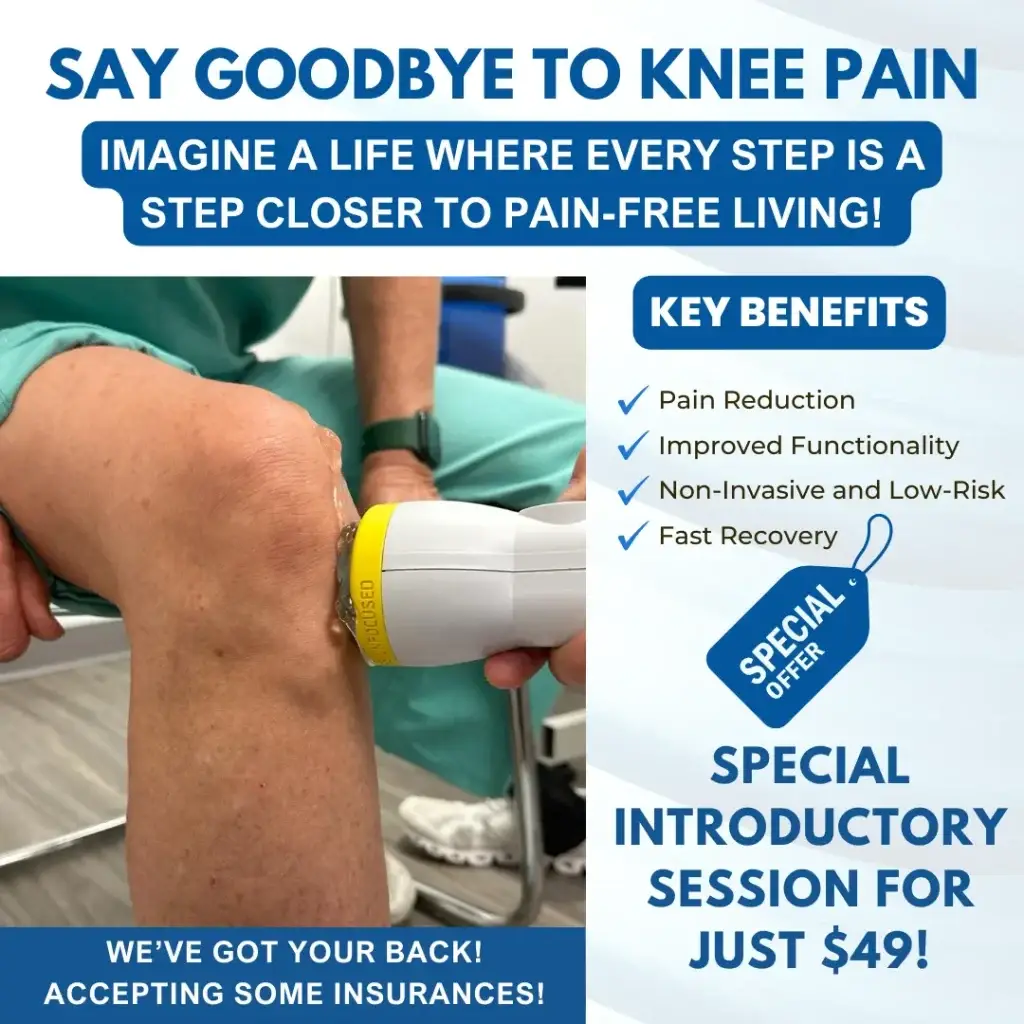In order to compare a normal knee vs Osteoarthritis we first need to understand the anatomy of the knee. The knee joint is made up of four bones, the femur, tibia, fibula and patella. The femur is the longest and strongest bone in the body and is the bone connecting the hip to the knee. It also attaches most of the muscles of the knee. The tibia sometimes called the shin bone is the bone connecting the knee to the ankle.
The fibula is the shorter and smaller thin bone that is located on the outside of the lower leg, that also runs parallel to the tibia. The smallest of the four bones is the patella (knee cap), this bone is located in front of the knee and it rides on top of the knee joint with knee movement.
The Knee Joint
The normal knee vs osteoarthritis knee is a healthy synovial hinge joint. The knee joint is a synovial hinge joint, which allows for flexion and extension or bending and straightening along with a bit of rotation. The knee is lined with synovium, which is connective tissue that lines the inside of the knee joint capsule. The capsule is a bubble like structure that surrounds the knee joint. The synovium helps produce lubrication and nutrients to the joints which allows the joint to stay healthy and to glide and move smoothly.
In a knee with osteoarthritis the hinge joint becomes stiff, thus a person will have decreased flexibility and range of motion. They synovium that produces lubrication also decreases the amount of synovium production, thus causing the joint to become stiff and rigid.
The normal knee vs osteoarthritis knee also has two types of cartilage. The first is articular cartilage that has a smooth surface and is located at the end of the femur and the tibia. The second is menisci which incompletely cover the superior surface of the tibia where it articulates with the femur. The menisci are the knees shock absorbers, protecting the articular surface of the tibia and also assisting the knee in rotation.
In the normal knee all of the above are normal, with smooth surfaces for the articular cartilage and thick menisci. In the degenerative osteoarthritic knee there is a loss of smoothness in the articular cartilage and the menisci can be frayed, decreased in size and even torn. This degeneration in the knee and the osteoarthritic changes can cause pain and inflammation along with difficulty with movements including bending, twisting, and pivoting.
Essential Ligaments of the Knee
The normal knee vs osteoarthritis knee also has four very important ligaments. These include the lateral and medial collateral ligaments which are located on the medial or lateral sides of the knee. This will help with supporting, and stabilizing the knee with medial or lateral movements such as pivoting, or cutting. The knee also has the anterior cruciate ligament and the posterior cruciate ligament. These ligaments are what keeps the knee stable with rotational movements. Also keeps the knee stable with walking, pivoting and turning. In the osteoarthritic knee, these ligaments can become inflamed, weak, frayed and even torn causing instability in the knee joint.
Classification of a normal knee joint versus and osteoarthritic knee
Now that we have discussed the normal anatomy of the knee we can look at a knee with osteoarthritis. One of the best ways of judging a normal knee versus a knee with osteoarthritis is through images such as X-rays, MRI’s or CT scans. However the X-ray is the best to show us the degenerative changes that are occurring in the knee. These degenerative changes can be seen through a classification system developed by Kellgram and Lawrence. The grading is as stated below: (based off the original scale)
- Grade 0 (none): definite absence of x-ray changes of osteoarthritis
- Grade 1 (doubtful): doubtful joint space narrowing and possible osteophytic lipping
- Grade 2 (minimal): definite osteophytes and possible joint space narrowing
- Grade 3 (moderate): moderate multiple osteophytes, definite narrowing of joint space and some sclerosis and possible deformity of bone ends
- Grade 4 (severe): large osteophytes, marked narrowing of joint space, severe sclerosis and definite deformity of bone ends

How did my knee go from being a normal knee versus an osteoarthritic knee?
There are many reasons for a knee becoming osteoarthritic. One of the main causes is trauma or injury. This can include a fall, slip, harsh twist, or repeated physical stress that can occur from repetitive motion from work or sports. A knee can become osteoarthritic from bone deformities, genetics, being overweight as well as age. The estimated median age of knee OA diagnosis is 55 years of age. About 9.29% of the US population is diagnosed with symptomatic knee OA by age 60.
Prevention to maintain a normal knee vs Osteoarthritis knee
Prevention is usually the best course of action to having a normal knee versus an osteoarthritic knee. This prevention includes keeping a lean waistline. Increase weight increases the chances for osteoarthritis. It is said for every pound of excess weight carried, 4 pounds of extra pressure is applied to the knees. So if you’re 10 pounds overweight, your knees absorb 40 pounds of extra pressure, which can damage the joints over time.
Thus maintaining a thin waistline is vital for prevention. At Waters Edge Medical Clinic we help our patients with various weight loss programs and body contouring programs including lipolight therapy and semaglutide.
Secondly, for helping with preventing osteoarthritis of the knee involves keeping the muscles of the leg strong and flexible. One of the most important muscles of the leg is the medial quadriceps muscle called the Vastus Medialis. This muscle helps maintain correct tracking of the patella. It is also the main stabilizing quadriceps muscle of the knee. It is also vital to maintain correct alignment of the legs, pelvis and feet. Thus it is vital to wear supportive shoes, exercise regularly and maintain a healthy diet and waistline.
What to do if my knee is hurting and I think I have osteoarthritis of the knee?
If you are having knee pain or discomfort it is best to come to Waters Edge Medical Clinic and receive a free consultation and screening. Our office is a natural pain and regenerative medicine clinic. Our team of professionals will meet with you and determine your best course of action. Our treatments help regenerate the affected area so that you can return to an active lifestyle. Our office offers ozone therapy, prolozone therapy, platelet rich plasma therapy (PRP), human cellular tissue or human biologics including stem cells, plus the new soft wave treatment.
Frequently Asked Questions

1. What is the difference between a normal knee and one affected by osteoarthritis?
A normal knee has smooth cartilage that allows for pain-free movement, while in Osteoarthritis, the cartilage wears down, causing joint pain, swelling, and stiffness. This leads to discomfort and difficulty in performing everyday activities.
2. What are the common symptoms of chronic knee pain caused by osteoarthritis?
The typical symptoms of Osteoarthritis include persistent knee pain, stiffness, swelling, and limited mobility. A common symptom includes a grinding or clicking sensation in the knee joint when moving.
3. What are the common symptoms of chronic knee pain caused by osteoarthritis?
At Waters Edge Medical Clinic, we treat Osteoarthritis and other chronic knee conditions with innovative solutions such as SoftWave therapy and regenerative medicine. These treatments reduce inflammation and promote the healing of damaged tissues, providing relief for chronic knee pain sufferers.
4. Can SoftWave therapy really help with knee pain caused by osteoarthritis?
Yes, SoftWave therapy is highly effective in treating knee pain from Osteoarthritis. It uses acoustic waves to stimulate tissue repair and reduce inflammation, providing long-term pain relief and improved knee function.
5. Is regenerative medicine available for chronic knee pain due to osteoarthritis at Waters Edge Medical Clinic?
Yes, regenerative medicine is offered at Waters Edge Medical Clinic for treating knee pain from Osteoarthritis. This advanced treatment encourages tissue regeneration and helps patients avoid more invasive procedures like surgery.
6. How long does it usually take to feel results from knee pain treatments at Waters Edge Medical Clinic?
For patients with Osteoarthritis, results from treatments like SoftWave therapy and regenerative medicine often start to appear after just a few sessions. Improvement in pain levels and mobility typically continues over several weeks, depending on the severity of the condition and the individual’s response to treatment.
Our commitment to using advanced therapies like SoftWave Therapy ensures that patients receive top-tier care for their knee pain. Are you ready to take the first step toward pain-free movement? Contact Waters Edge Medical Clinic today!


